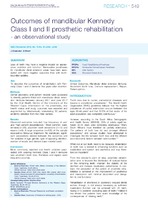| dc.contributor.author | Chamoko, Joanna | |
| dc.contributor.author | Khan, S | |
| dc.date.accessioned | 2020-10-30T08:55:53Z | |
| dc.date.available | 2020-10-30T08:55:53Z | |
| dc.date.issued | 2020 | |
| dc.identifier.citation | Chamoko, J. and Khan, S., 2019. Outcomes of mandibular Kennedy Class I and II prosthetic rehabilitation - An observational study. South African Dental Journal, 74(10). | en_US |
| dc.identifier.issn | 0375-1562 | |
| dc.identifier.other | DOI;10.17159/2519-0105/2019/v74no10a5 | |
| dc.identifier.uri | http://hdl.handle.net/10566/5326 | |
| dc.description.abstract | Tooth loss due to caries, periodontal diseases and
trauma is sometimes unavoidable.¹ The World Health
Organization (WHO) guidelines indicate that the highest
prevalence of partial edentulism occurs between the
ages 35-44 years2
and that 12.6% of that sector of the
adult population was completely edentulous.2
However, according to the South Africa Demographic
and Health Survey (SADHS), 23% of adults aged between 35-44 years were completely edentulous.3
Many
South Africans must therefore be partially edentulous.
The patterns of tooth loss do vary amongst different
populations,4
and various studies have attempted to
investigate the link between tooth loss and the different
socio-economic factors between communities. | en_US |
| dc.language.iso | en | en_US |
| dc.publisher | University of the Western Cape | en_US |
| dc.subject | Patient opinion | en_US |
| dc.subject | Repair | en_US |
| dc.subject | Denture replacement | en_US |
| dc.subject | Abutment tooth loss | en_US |
| dc.subject | Mandibular distal extension dentures | en_US |
| dc.subject | Clinical Outcomes | en_US |
| dc.title | Outcomes of mandibular Kennedy Class I and II prosthetic rehabilitation - an observational study | en_US |
| dc.type | Article | en_US |

